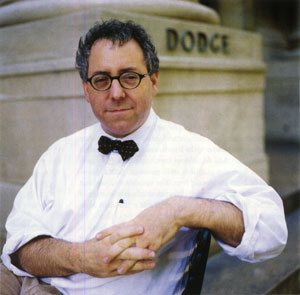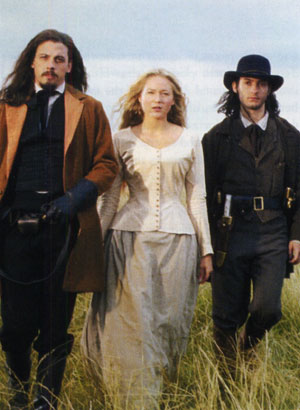
|
James Schamus
|
James Schamus, who divides his time between teaching film in Columbia University's School of the Arts and producing and writing films, has written and produced a new movie, "Ride with the Devil," in which he and his long-time collaborator, director Ang Lee, present a vision of the Civil War very different from the one most Americans hold.
Instead of a clear-cut story of North against South, good versus evil, the action takes place in what Schamus terms "a weird liminal zone," the Kansas-Missouri border, which was not only the meeting ground of the North and South, but at the time was also the Western frontier of the United States. The movie tells the little-known story of the Bushwhackers, a rag-tag militia of Southern sympathizers who perpetrated guerrilla warfare on the Union army.
"Missouri is an interesting exception to our stereotyped ideas about the war: it was a Union state that was also a slave-holding state. A lot of people out in the countryside were pro-Southern, but the state itself did not secede. Under military rule throughout much of the war, Missourians really felt this as an invasion from the North."
The state was not a major theater of operations for the army; however, locals formed loosely organized gangs of guerrillas and took matters into their own hands, creating what Schamus terms "a kind of American Bosnia, with friends and neighbors fighting each other."
The Bushwhackers, themselves, were also unorthodox, famously flamboyant in their style of dress. "They really were the rock-and-rollers of the Civil War," said Schamus. "It was a badge of honor to wear a highly embroidered vest and shirt that your girlfriend had made for you. These guys didn't use shotguns or rifles that much, or muskets--they were real experts with pistols. They would carry, at any given time, between six and ten loaded pistols. They would sew heavy pockets and holsters into all their clothes so they could grab them very quickly if they got into an ambush."
Schamus's screenplay, based on Daniel Woodrell's novel Woe to Live On, centers around Jake Roedel (played by Tobey Maguire), who defies his German-born father to join his best friend Jack Bull Chiles (Skeet Ulrich) as a Bushwhacker. Schamus explains that Jake's father was one of the Germans who emigrated to the U.S. after the failure of the 1848 revolution in Germany, and whose political sympathies were aligned with the North. "For young Jake, who's been acclimated and really grown up as a Southerner, to ride off with his best friend is not only a personal break with his father, but a political one," he said.
Another main character who embodies the conflicting loyalties that emerged at this historical moment is a black man and freed slave, Daniel Holt, played by Tony Award-winner Jeffrey Wright. Holt fights for the Confederacy alongside his former master, George Clyde (Simon Baker), despite the evident conflict of interest. "The character played by Jeffrey Wright is very much the exception to the rule," said Schamus. "Most black men working on the side of the South were doing so in order to get as close to the Northern lines as possible and get out of there. . .It is a little-known fact that a small number of free and enslaved African-Americans worked on the side of the Confederacy during the war, and their stories are among the most fascinating of the period."

|
(From left) Skeet Ulrich, Jewel Kilcher and Tobey Maguire
|
The movie also represents the screen debut of singer-songwriter Jewel, who plays the part of Sue Lee, a young widow who becomes involved with the band of self-made soldiers. Director Ang Lee decided to take a risk and cast a fresh face, saying that "Physically, she matched the part. More importantly, she brings to the role an honesty and a lack of pretension that are very much in keeping with her character. I think Jewel's early years growing up in Alaska and struggling to succeed have given her character, and a genuine quality."
Early reviews of "Ride with the Devil" have already singled the movie out for praise for its nuanced treatment of the period. Variety's lead film critic, Todd McCarthy, describes it as a "brutal but sensitively observed film" and calls attention to "an outstanding rhythm to the editing and contrasting of scenes..[and] beautiful small details." He points out that "James Schamus' intelligent script...pays attention to linguistic niceties. The language of most of the characters, who are neither Southern nor Northern, possesses a dry, precise, unconsciously poetic quality that represents a pleasure unto itself, and the attention given to written letters, the way in which men deal with a self-possessed woman, and the lyrical visuals often bring to mind the work of Francois Truffaut." Jack Mathews, film critic for the Daily News, describes Schamus' script as "word-perfect," and writes "'Ride With the Devil' is the best movie I've seen all year." He gives it gives it four stars, his highest rating.
Many critics have noted that "Ride With the Devil," an action film with a large component of violence, represents a departure in subject matter and genre for the filmmaking team of Lee and Schamus.
"We didn't consider this a Western, even though it has horses and guns. But we watched a lot of B-Westerns, by Anthony Mann and Budd Boetticher for example, mainly for how they dealt with things like horses, for technical research," said Schamus. "We read the film as a kind of ur-Western. We thought we'd make a film which had as its last image the prototypical first image of the Western genre. Our final image of the movie is of a guy riding off into the sunrise, into the South, that single, solitary figure.
"It's an image that you see at the beginning of 'The Searchers,' or 'Shane,' where a lone rider comes up and deals with the landscape and the emerging social order. And in our own film we tried very sneakily to subvert that by making that person black and making his story the propelling back story for the Western genre--not the usual back story which has to do with the decommissioned Southerner who's lost everything and is now in the West."
"Ride with the Devil" represents Schamus's sixth collaboration with director Ang Lee. Their critically acclaimed 1997 feature "The Ice Storm" dissected 70s American suburbia, and garnered a best screenplay award at the Cannes Film Festival for Schamus; their film of Jane Austen's nineteenth-century comedy of manners Sense and Sensibility (with Schamus producing) resulted in a screenwriting Oscar for adapter and co-star Emma Thompson. Other movies created by the team include "The Wedding Banquet" and "Eat, Drink, Man, Woman."
"Ang brings a couple of things to the movie: an enormous attention to detail and to the specifics of people's real experience," said Schamus. "That allows him to take advantage of the second thing that he brings: that is, he doesn't have a partisan approach, having not grown up here (Lee was born in Taiwan). While he is certainly for freedom and emancipation, he doesn't approach our history with the same baggage that Americans do."
Schamus, who holds both a BA and an MA from UC Berkeley in English literature, is unusual in his combination of academic, film producing and writing activities. At Columbia, where he is associate professor of film history, theory, and criticism, Schamus commuted back and forth from the set of "Ride With the Devil" in Missouri to teach a course on the American Western.
Asked how his teaching feeds into his work as a producer, he says, "This is a very good example of it: I was able to mentally prepare for 'Ride with the Devil' while preparing for, researching and teaching the class. The dialogue with my students over a lot of these issues ended up winding its way into the concerns of the script. We spent a lot of time in the class discussing the way in which racial politics figures in the genre, the way in which the films configure male friendship and masculinity and femininity, and the way American history, in particular the Civil War as a background, gets both repressed and reconfigured in pop cultural artifacts like the Western. As you see in the movie, those things are very central."
|
